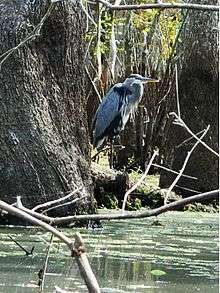Honey Island Swamp
The Honey Island Swamp (French: Marais de l'Île-de-Miel) is a marshland located in the eastern portion of the U.S. state of Louisiana in St. Tammany Parish. Honey Island earned its name because of the honeybees once seen on a nearby isle.[1] The swamp is bordered on the north by U.S. 11, on the south by Lake Borgne, on the east by the Pearl River and the west by the West Pearl River.[2]


.jpg)
It is one of the least-altered river swamps in the United States. Considered by many to be one of the most pristine swampland habitats in the United States, the Honey Island Swamp covers an area that is over 20 miles (30 km) long and nearly 7 miles (10 km) across, with 35,619 of its 70,000 acres (280 km²) government sanctioned as permanently protected wildlife area. Animals that live in the Honey Island Swamp include alligators, raccoons, owls, wild boars, nutria, snakes, turtles, bald eagles and black bears.[3][4]
This swamp is also the home of the legendary Honey Island Swamp monster, which has from time to time been known as the "Tainted Keitre". Honey Island Swamp is located on the Pearl River wildlife management area and managed by the Louisiana Department of Wildlife and Fisheries.
Swamp Monster
The swamp is famous for being the home of the Honey Island Swamp monster legend.[5] The purported creature is described as bipedal, seven feet (2.2 metres) tall, with gray hair and yellow eyes. It is said to be accompanied by a disgusting smell. Footprints supposedly left by the creature have four toes. The first claimed sighting was in 1963 by Harlan Ford, a retired Air traffic controller who took up wildlife photography. After his death in 1980, a reel of Super 8 film showing the creature was allegedly found among his belongings. In 1974 the monster gained national fame after Ford and a friend claimed to have found unusual footprints in the area, as well as the body of a wild boar whose throat had been gashed. Ford continued to hunt the creature for the next six years. The idea of a large, ape-like creature in the area is not without its critics, notably the local ecologist Paul Wagner, who with his wife Sue run nature tours in the area. They claim they have not seen any evidence for it. A local legend tells of a train crash in the area in the early twentieth century. A travelling circus was on the train, and from it a group of chimpanzees escaped, interbreeding with the local alligator population.
References
- Herndon, Ernest (2003). Canoeing Louisiana. Jackson: University Press of Mississippi. p. 198. ISBN 1-57806-426-0.
- "Coastal Management Division's, Gulf Ecological Management Site, Honey Island Swamp". Louisiana Department of Natural Resources. Archived from the original on 2006-10-06. Retrieved 2008-05-20.
- "Cajun Encounters Honey Island Swamp Tours". Archived from the original on 2015-03-16. Retrieved 2014-07-19.
- "Pearl River WMA". Retrieved 2019-11-28.
- Scott Francis (2007). Monster Spotter's Guide to North America. How. ISBN 1-58180-929-8.